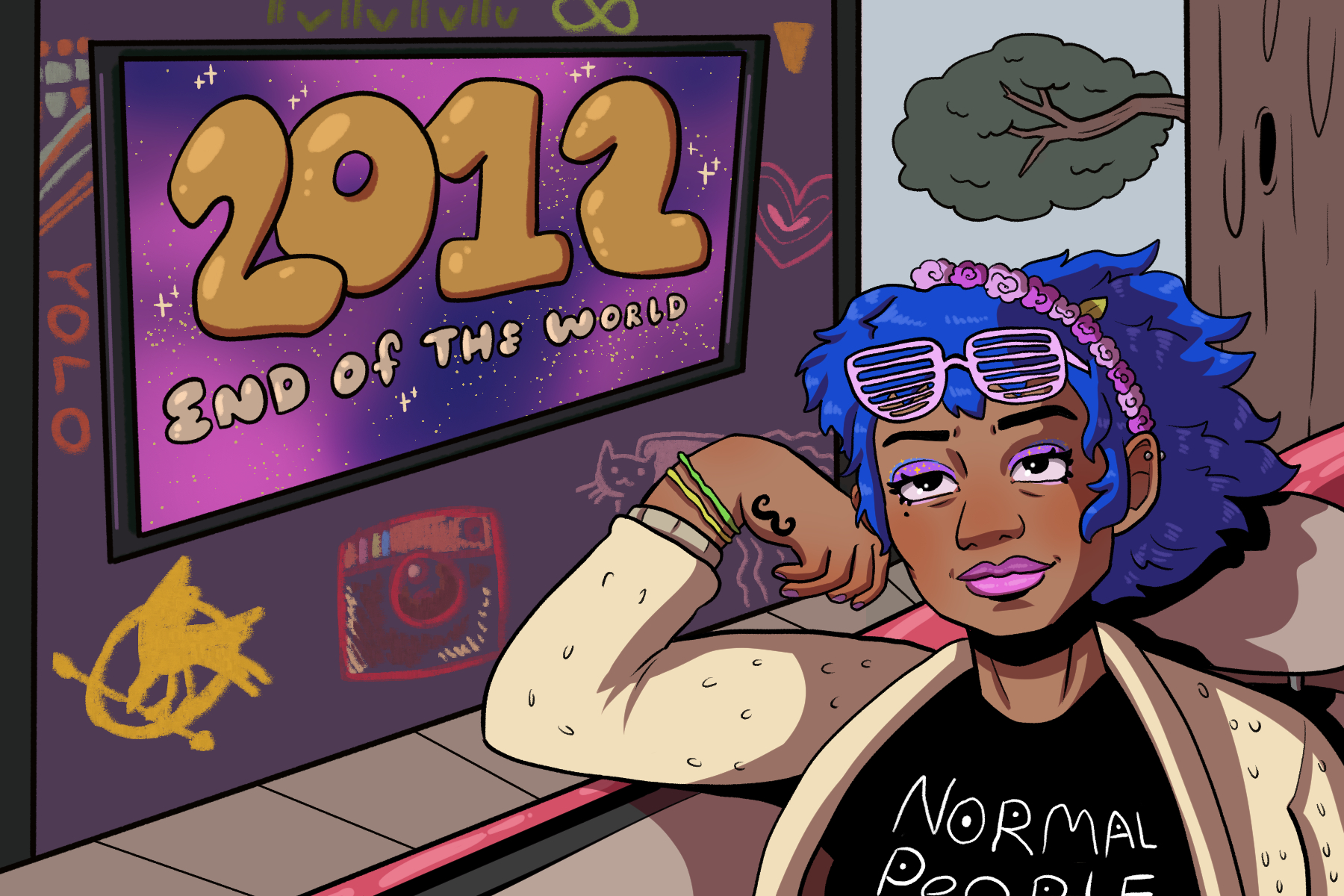While 2012 could be memorialized by the London Summer Olympics and Barack Obama’s reelection as president of the United States, the year is remembered by many as the one in which the world was going to end. About a decade later, the US found itself recovering from another election year; a year filled with so much loss, it felt as if the end of the world had become a reality. Through observing pop culture in times such as these, we can discover ways in which people coped and persevered through the fear of the end, or in the case of 2022, the trauma of making it to the other side.
According to the Mesoamerican Long Count calendar, Dec 21st, 2012 was considered the end-date of a 5,126-year-long cycle. People believed this date possessed a unique set of astronomical alignments which suggested that the world would experience a major spiritual shift – a new era would be upon us. This too prompted theories of a large catastrophic event occurring on this date such as the collision of Earth and the mythical planet, Nibiru.
This date had been brought up in popular media as early as the 90s television show, “The X-files,” a show based around alien and supernatural conspiracies. As soon as it was realized that this date was approaching, the fear of doomsday began to set in.
With that, there was a rise in sales of underground blast shelters after 2009 in preparation for 2012. According to a BBC News article written on Dec 19th, 2012, one in 10 people were anxious about the world ending. In fact, NASA’s public outreach website, “Ask an Astrobiologist,” received over 5,000 questions regarding the topic and proved many people to have a strong looming anxiety over this theory. The rise of social media at this time and its ability to heighten stories such as these is part of the reason this theory gained so much traction.
While the world did not come to an end on this date, ten years later, in 2022, the world found itself recovering from the previous couple of years. In 2020, the world found itself hit by a global pandemic and the United States was in the midst of a political and civil uproar, and the future had never been so uncertain for so many. The country saw an eruption of protests following the death of George Floyd in support of the Black Lives Matter movement. Instigated by the police, some of these protests across the country turned violent, leading to a push to defund the police. With the fate of the country in the delicate hands of the year’s presidential election, many feared that government officials who were meant to be leading the people to positive change, had their focus elsewhere. As soon as 2021 began and this never ending election seemed to have finally come to a close, the United States Capitol was breached by the supporters of Trump, in denial of the election results. The insurrection of Jan 6th, 2021 quickly became an event of multiple casualties. At some moments, the potential for a real apocalypse truly seemed to be on the horizon.
Looking at how these experiences were reflected in pop culture of the times, popular music is one of the strongest forms of expression that will expose some of the true feelings that were felt by those living through it. While there are a variety of factors that go into songwriting, common themes emerge in song titles from both 2012 and 2022.
The titles of 2012 pop songs show a trend of expressing uncertainty of the future, as many reference having limited time to experiencing life at a young age. Some examples of this occurrence would be “We Are Young” by Fun, “Live While We’re Young” by One Direction, “Die Young” by Kesha and “Young, Wild & Free (feat. Bruno Mars)” by Snoop Dogg and Wiz Khalifa. These song titles also tend to reference the end of something, saying goodbye, or having limited time to do something; for example, “Blow Me (One Last Kiss)” by P!nk, “One More Night” by Maroon 5, “50 Ways to Say Goodbye” by Train, “I Will Wait” by Mumford & Sons, “It’s Time” by Imagine Dragons and “We Are Never Ever Getting Back Together” by Taylor Swift.
While none of these songs are directly written about the end of the world, it is clear that there was a sense that time was running out in 2012. While not everyone may have fully believed that the world would truly end in December of this year, it certainly influenced the culture and overall feeling about life at this time. The music of 2012 contemplates this unique idea of human existence nearing an end.
As pop songs are often about relationships, we see this perspective through the lens of an artist such as P!nk who decides the lover she is currently pursuing is no longer worth her time, as the time she has left is precious. This is evident in the lyrics of “Blow Me (One Last Kiss),” as she states, “I think that life’s too short for this / I want back my ignorance and bliss / I think I’ve had enough of this / Blow me one last kiss.” There is a similar perspective in the lyrics of Ke$ha’s “Die Young,” as she sings, “So while you’re here in my arms / Let’s make the most of the night / Like we’re gonna die young,” – she celebrates what she has while she has it.
These perspectives are similar to the philosophy of Roman philosopher, Seneca, who writes, “if each of us could have the tally of his future years set before him, as we can of our past years, how alarmed would be those who saw only a few years ahead, and how carefully would they use them!”
The music of 2012 expresses fear of a looming doom in a way that has been unmatched ever since. The tragedy that had been anticipated arrived 8 years later in the form of COVID-19 and the political uproar of 2020.
As for the song titles of 2022, the visible themes have less to do with taking advantage of the moment at hand while appreciating the past. Instead, there is more of an urgency to move on to new horizons or at least return to a reality that is more familiar. Some examples include “As It Was” by Harry Styles, “About Damn Time” by Lizzo, “Until I Found You” by Stephen Sanchez and “Life Goes On” by Oliver Tree.
While these songs do not directly discuss the traumatizing events that happened in recent years, they do possess qualities of moving on rather than stagnating.
Harry Styles’ “As It Was,” is a prime example of this perspective. The main line of the chorus, “You know it’s not the same as it was,” is explained by Styles in a 2022 interview with Apple Music. He stated, “For me, everything that happened in the pandemic, like, it’s never gonna be the same as before. All of the things happening in the world, it was so obvious that you just can’t go backwards, whether that’s us as people, or me in my personal life, or any of those things, you learn so much in those moments.”
It is interesting to consider this past decade as a whole; the emotional preparations made for a tragic event that never even ended up happening but then being followed by a truly catastrophic year almost a decade later and the emotional reparations that followed. Through the words of the 2012 and 2022 musicians alike, there are lessons to be learned in the ways we prepare for tragedy and then recover from it. While the music of 2022 represents ways in which it may be hard to move on from the past, it is a reminder to look at what’s ahead. Meanwhile, the music of 2012 is a reminder to not dream too fondly of the future, as it is important to live like there’s no tomorrow.
















